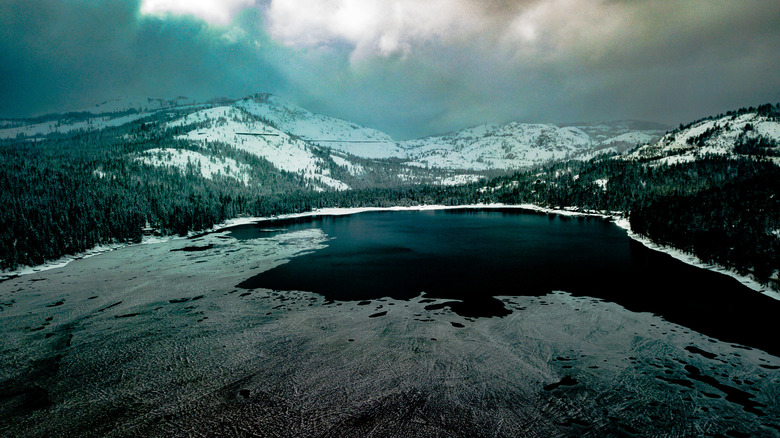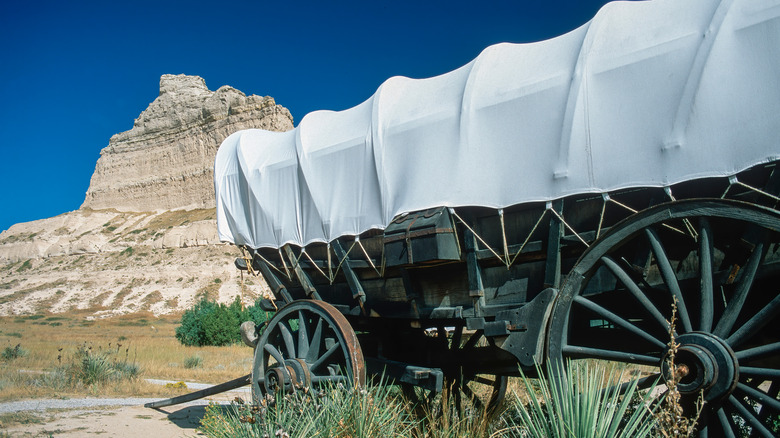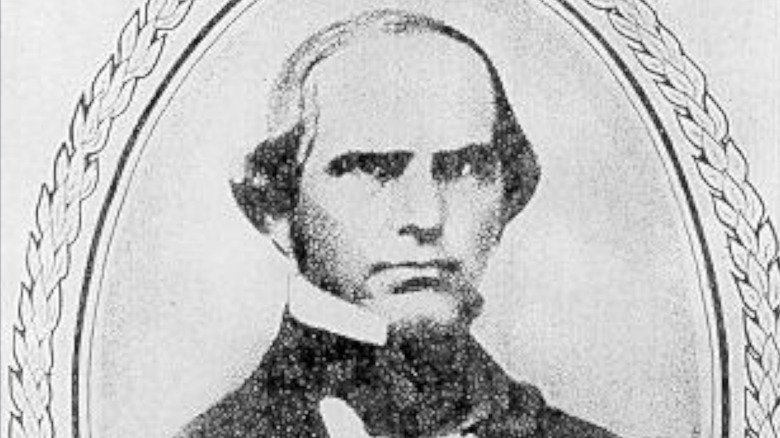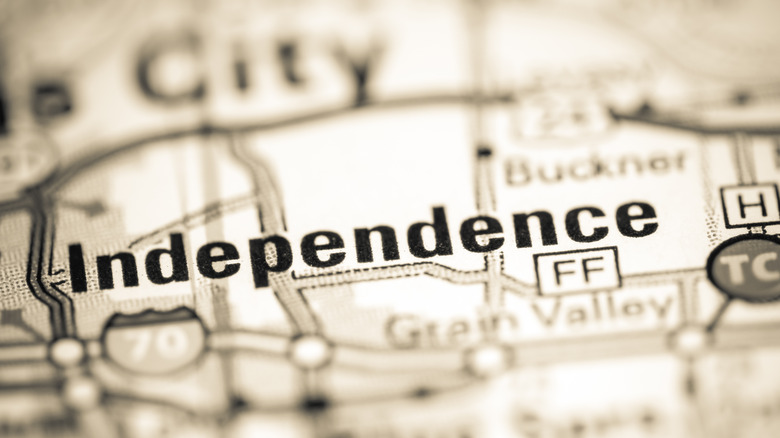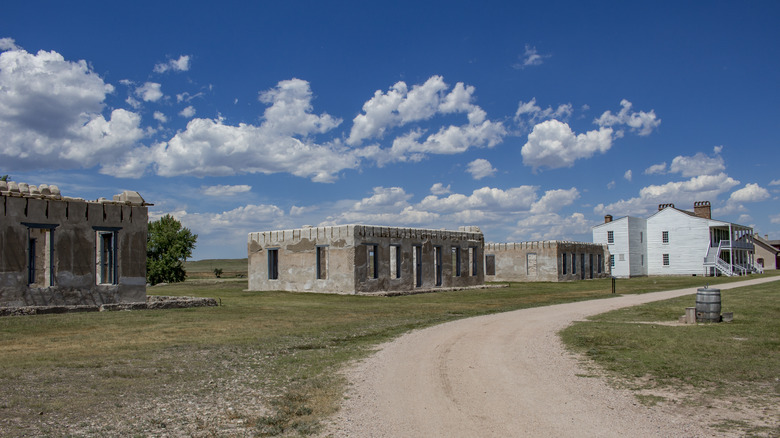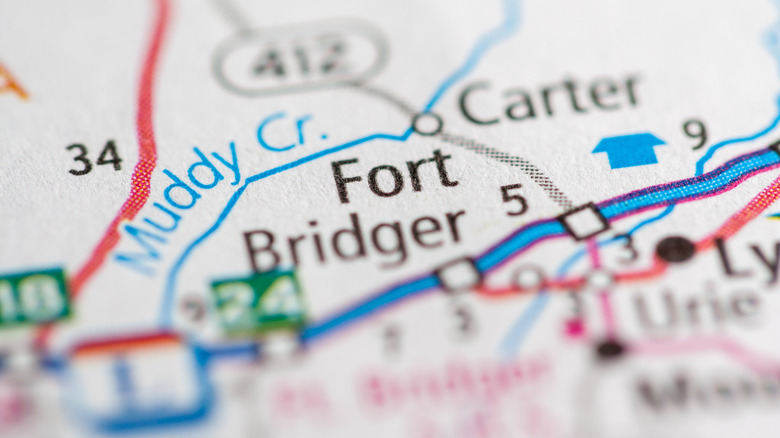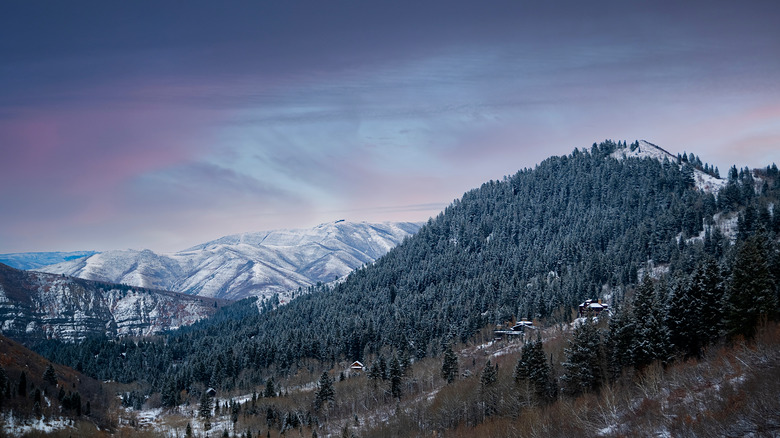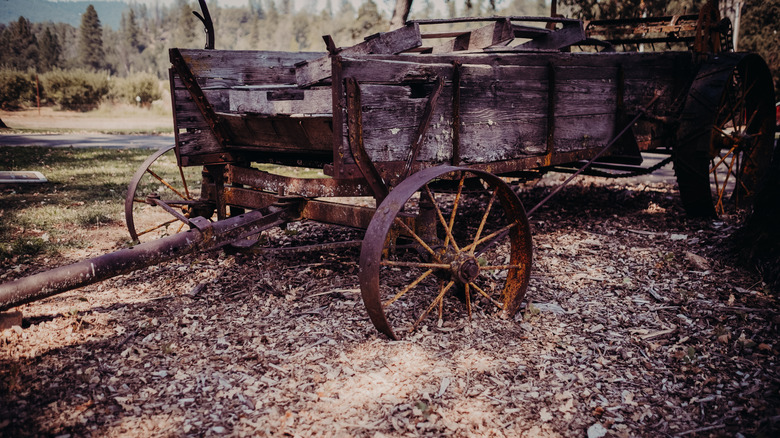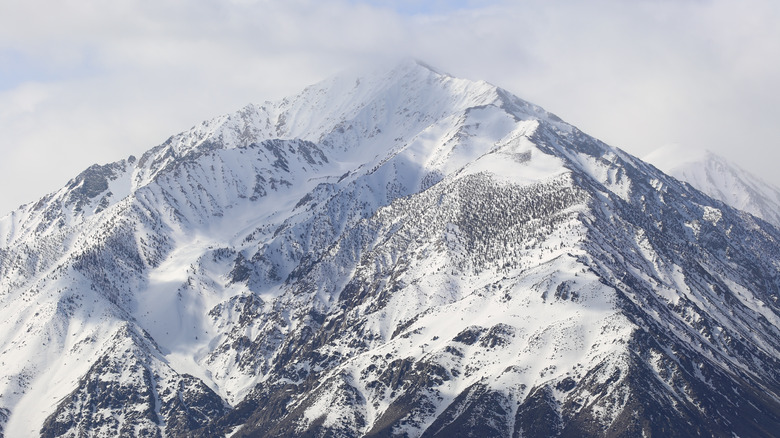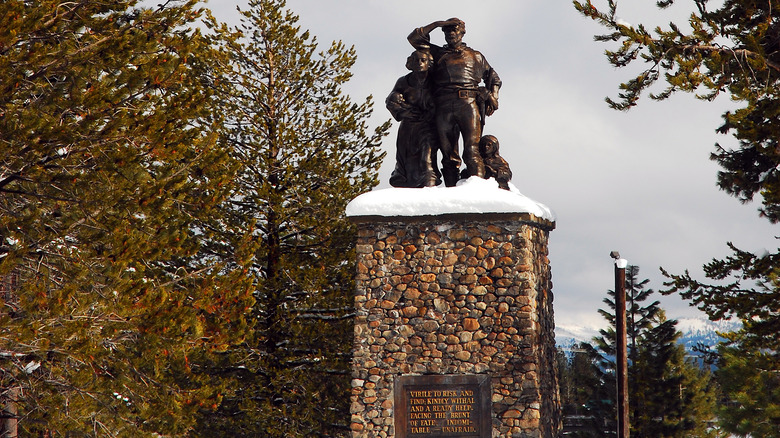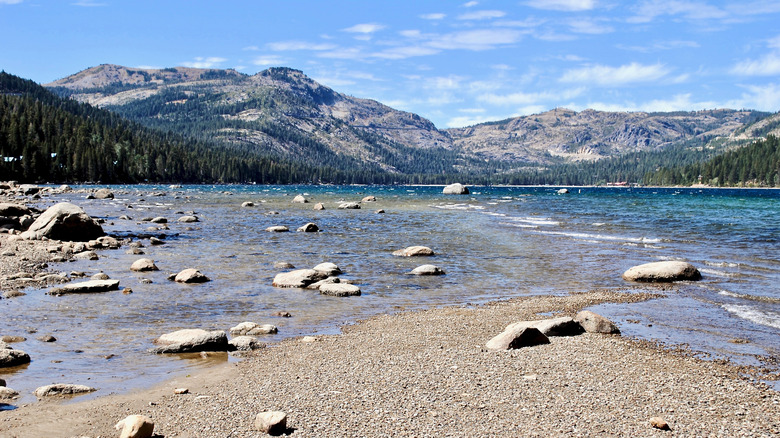The Untold Truth Of The Donner Party
Was it hubris? Was it naivete? Was it a plan so wild, it just might work — except it didn't? As History tells us, there were so many factors at play for the Donner Party, a wagon train of westbound immigrants headed for California from the Midwest. And almost none of those factors were positive. In far too many ways, they were doomed from the start.
Immigrant trains used oxen to pull heavy wagons full of household goods and supplies, with an eye to sufficient clothing, tools, and food — especially food — to walk from Missouri to Western California. The National Oregon/California Trail Center records that a pace of 15 to 20 miles a day was considered good when the terrain wasn't challenging and the weather cooperated. Most tried to start the trip no later than mid to late April, but the Donners and company didn't set out until May 12, 1846, according to History. Weather played a huge part: caught on the trail, winter could kill. And it did.
Besides the late start, the Donners took some bad advice from a man who claimed to know what he was talking about — but didn't. They were given directions to an allegedly faster shortcut for the route to California. They nearly died crossing the Utah desert and lost valuable time trying to force their way through wilderness that was less than wagon-friendly.
The United States expands west
According to Legends of America, while the western part of North America had seen permanent European settlements dating back to the earliest days of the fur trade, the early 19th century was the start of the United States' large push to settle the western part of the continent. Starting with Thomas Jefferson's Louisiana Purchase and the Lewis and Clark expedition, the American frontier began pushing farther and farther west.
By the 1820s, Ohio, along with parts of Illinois, Indiana, and Missouri were seeing the presence of American settlers and in just a few decades, American settlers had reached the Rocky Mountains.
Entering the 1840s, there were still lots of people looking to migrate west and almost as many reasons for wanting to make the trip. Some of the settlers were in search of land which was becoming more scarce in the eastern part of the country, while others sought the get-rich-quick scenario that came with finding gold, while others — namely a large number of Mormons that made their way west — were searching for a place to freely practice their religion. With so many motives for journeying west, there were also several ways to get there.
Hastings publishes a shortcut to the west
According to National Geographic, several popular trails served as guides to settlers. Perhaps most famous of all is the Oregon Trail, which started around the border of Missouri and Kansas before trudging across the Great Plains and snaking through the Rocky Mountains. There was also the Mormon trail which started in western Illinois and followed a similar path to the Oregon Trail but ended near what became Salt Lake City, Utah. Yet another was the California trail that guided settlers west of the Rocky Mountains.
Lansford Hastings was one of the people who made his way west, doing so in 1842 along the Oregon Trail (via California Trail Center). Hastings was born in Mount Vernon, Ohio in 1819. While many settlers had taken to the westward trails to escape difficult lives, having been born the son of a doctor, Hastings had a comparatively comfortable life.
After attending law school, Hastings made the trek to Oregon, but by 1843 he had made his way south to California. At the time, California was mostly Mexican territory, and Hastings recognized that there were immense opportunities there. He published a book called "The Emigrants' Guide to Oregon and California," in which he laid out a shortcut to California that would shave off nearly 400 miles over easy terrain.
However, according to Legends of America, Hastings never tested this route. Little did he know that his untested shortcut would inspire one of the American West's greatest tragedies.
Hastings' book falls into the hands of James Frazier Reed
The idea for the group that would become infamously known as the Donner Party was started by an Illinois businessman named James Frazier Reed (via Legends of America).
Reed, like so many before him, wanted to travel west in search of riches, but he was also incentivized by the prospect of a better life for his wife, Margaret. She experienced severe headaches, and Reed thought that perhaps the West Coast climate would help her health. Reed read through a copy of Hastings' "The Emigrants' Guide to Oregon and California" and was inspired to put together a group for a westward journey.
The initial group consisted of nine wagons and 32 people, with nine of them being members of the Reed traveling party, which included James, Margaret, their four children, Margaret's mother, and a pair of hired servants. While the trip was no doubt going to be arduous, James Reed paid to make sure that his family traveled comfortably. They did so in a two-story wagon that took eight oxen to pull and featured a stove, cushioned seats, and even bunks. It was so extravagant that Virginia Reed, who was 12 years old at the start of the trek, called it the Pioneer Palace Car.
Over time the group would expand as several other families joined what became known as the Donner Party: the Graveses, Breens, Murphys, Eddys, McCutcheons, Kesebergs, Wolfingers, and, of course, the Donners.
The journey west begins
According to Legends of America, the group set out from Springfield, Illinois on April 16, 1846, and their first waypoint was the town of Independence, Missouri. Independence was the starting point for both the Oregon and California trails.
Among the group were two brothers in their 60s — Jacob and George Donner — and their families. This trip wasn't a first for the Donners. They were of German descent and had started traveling before this event began, starting in North Carolina and moving progressively farther west each time with stops in Kentucky, Indiana, and Illinois (via NCpedia). Their respective broods made up a large chunk of the overall traveling party. It's believed that the Donners were also intrigued by Hastings' proposed shortcut to the west coast, as Jacob Donner kept a copy of his book in his saddlebag.
What those in the Donner Party didn't realize was that a strange coincidence with some serious irony to it was taking place across the country. On the same day, as they left Springfield, Lansford Hastings was departing California to see his proposed shortcut for himself.
James Reed receives a warning
They reached Independence, Missouri three weeks later. There they resupplied and started again, eventually joining another wagon train about 100 miles west of Independence (via Legends of America). This expanded the group to 87 people.
Weeks later, the group would reach Fort Laramie Wyoming. There, James Reed met a friend from Illinois who had traveled with Hastings eastward. This friend advised Reed not to take Hastings' shortcut, telling him that they would never make it using wagons, as the route was barely traversable on foot. He also warned Reed of the dangers posed by the desert and the Sierra Nevada mountains.
More wagons joined the group in Fort Laramie, and upon reaching the continental divide at the Rocky Mountains, a man with a letter from Hastings met them. The letter said that Hastings himself would meet them in Fort Bridger Wyoming, to show them where to take his shortcut, which was becoming known as Hastings' Cutoff.
The Donner Party's big mistake
They had no way of knowing it at the time, but the Hastings-inspired audible that would cost many in the Donner Party their lives happened near Wyoming's Little Sandy River.
To that point, the group had followed the established California Trail, but Little Sandy River marked the point where the trail split with Hastings' Cutoff. A schism occurred within the group with some of the pioneers heeding the warning James Reed had received in Fort Laramie and opting to continue on the California Trail.
Meanwhile, the other group who were willing to risk it on the unproven alternative route selected George Donner as their new leader.
The Donner Party followed the Hastings Cutoff to Fort Bridger, but instead of meeting Lansford Hastings himself, they found only a letter that had been left with a group of other travelers. The note said that Hastings had joined another group and had gone ahead, encouraging the Donner Party to catch up, and saying that he would mark the trail for them (via History). Feeling confident about Hastings' proposition, the group — consisting at this point of somewhere around 89 people and 20 wagons — left Fort Bridger.
Early signs that things weren't going to end well
If any member of the Donner Party was still hopeful that the rest of their journey to California along Hastings' Cutoff would be smooth sailing, they would be having second thoughts by the time the group reached Weber Canyon.
According to History, Hastings had promised them that Weber Canyon would provide them a safe way of traversing the Wasatch Mountains, a rugged part of the Rocky Mountains located in modern-day Utah.
But upon reaching the canyon, the members of the Donner Party found another note from Hastings. This note warned them that this part of the route was more dangerous than he had initially believed. He advised them to wait there until he could return and show them a better way through the mountains. This put the Donner Party in a bind. To backtrack to Fort Bridger where they could pick up the California trail would cost them days. They decided to wait for Hastings, but when he still hadn't shown up after eight days, they sent a messenger into the canyon to find him.
The party's messenger returned with instructions for an alternative route, which would take them through. The Donner Party traversed this path successfully, but it turned out that it was more difficult than Weber Canyon would have been, as the members of the Donner party were faced with thick trees and massive boulders.
The trouble with lost time
While returning to Fort Bridger would have cost the Donner Party a lot of time, it paled in comparison to what Hastings' alternative through Wasatch Mountains the route cost them. By the time they reached Utah's Great Salt Lake, the detour had cost them 18 days (via History). Wasting so much time meant wasting valuable supplies. Making matters even worse, according to Legends of America, the party had several wagons get stuck in the mud and were forced to abandon them, losing them even more supplies.
Next, the party traversed the Great Salt Lake Desert, which Hastings told them would take two days. Not only did it take more, but soft, wet sand caused more wagons to be abandoned. The stretch of the journey was 80 miles and during the journey, they lost 32 oxen.
The attitude of party members began to shift as they began getting frustrated with both Lansford Hastings and the man who had started many of them on the journey in the first place — James Frazier Reed.
Lost time also meant that by the time the Donner Party reached the Sierra Nevada mountains it was late in the year, when the weather in the mountains is at its most treacherous.
The Donner Party in the Sierra Nevadas
The Donner Party had finally made it to the Sierra Nevada mountains, but because of the many delays they had faced, they got there as the fierce winter weather started to appear. According to History, heavy snowfall on October 28, 1846, blocked the trail the party needed to take and trapped them in the mountains. Around this time, a broken axle on Geoge Donner's wagon caused the group to split up, with most of the Donner family staying behind.
Multiple attempts to traverse the trail anyway failed, and the remaining party members were forced to build shelters to wait out the winter. Multiple families were forced to share hastily built cabins, crowding together for warmth, per Legends of America. Food dwindled further, and they were forced to kill and eat the last remaining ox that November. After that, they ate whatever they could find including bones and bark.
By mid-December, a group of five men, nine women, and one child took a chance and left the camp to try to make it over the mountains. This group quickly ran out of food and was caught in a blizzard. As members of this group died, the survivors turned to cannibalism.
On February 5, 1847, the second relief party, which included James Reed, left to search for survivors. Two weeks later they found what they thought was a deserted camp but quickly learned it wasn't, and many of those still there were either close to death or had experienced mental breakdowns.
A memorial marks the site of the tragedy
The party really did eat everything else first — oxen, then their hides; leather; bones cooked and re-cooked (via NPR). "They ate literally everything before they had to turn to human flesh," explains Michael Wallis, author of "The Best Land Under Heaven: The Donner Party in the Age of Manifest Destiny." "They of course killed the great oxen, the horses, everything, and ate that meat. They boiled the hides, they picked out the bone marrow, they made this gelatinous, awful goo from the hides, and it had very little, if any, nutritional value." After everything else was gone, they were then left with each other. It's unclear who might have been deliberately murdered to provide meat for the survivors; it's certain that two Native Americans were shot and butchered.
In a February 2017 interview in Smithsonian, Bill Schutt, author of "Cannibalism: A Perfectly Natural History," said, "We have these sets of rules we try to follow. But when the going gets tough, that stuff eventually goes out the window ... . There's a biological directive to survive and at that point, when you reach that extreme, you're not worried about the fact that there's a taboo. You simply want to live."
Rescue parties finally reached them in April 1847. Of the 81 trapped by the snow, 45 walked out alive. Roughly half had engaged in cannibalism. Only two of the original dozen families made it to California without suffering a death.
Word of the Donner Party spreads
The grisly tale of the Donner Party found its way into newspapers in 1847. According to Legends of America, those who survived the Donner Party ordeal were painted as murderers and derided for poor conduct, including alleged cannibalism.
Survivors' accounts of what happened during the winter of 1846 and 1847 varied a great deal. Blame was placed on Lansford Hastings for his shortcut, which fell out of use almost immediately, while others blamed James Reed for ignoring the warning he had received at Fort Laramie.
The Donner Party incident and the publicity it received caused a significant reduction in the number of people traveling across the continent, but that dip wouldn't last long. In 1848, just a year later, gold was discovered in California. It was the beginning of the Gold Rush, and by 1849, thousands of people were once again racing out to California in search of riches.
Ironically, many of these people traveled to the Sierra Nevada mountains and the surrounding areas, the same place where many members of the Donner Party met their deaths.
